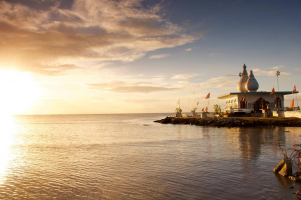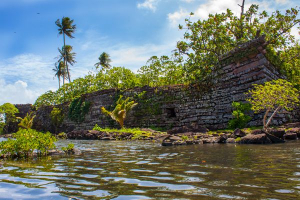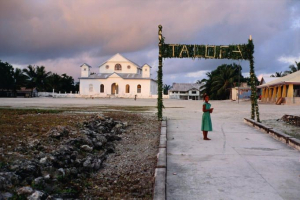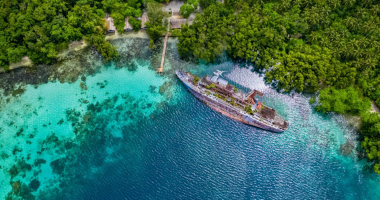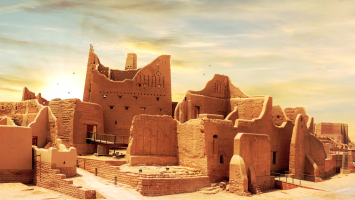Top 5 Most Beautiful Historical Sites in Guyana
Guyana is a sovereign nation in South America's northern landmass. Guyana's best historical landmarks are stunning and well worth seeing. Guyana is part of the ... read more...Caribbean region because of its close ties to the history, culture, and politics of the Caribbean countries. The country is bordered on the west by Venezuela, on the southwest and south by Brazil, on the north by the Atlantic Ocean, and the east by Suriname. Guyana is now home to a diverse ethnic population, including Africans, Indians, Amerindians, and others. Although English is the official language, the majority of the population speaks English-based creole languages. Georgetown, Guyana's capital, is the country's only significant metropolis. Here are 5 most beautiful historical sites in Guyana.
-
Known as one of the most beautiful historical sites in Guyana, St George's Cathedral is the primary cathedral of the Anglican Province of Western Australia and the metropolitical Diocese of Perth, and it is located in the center of Perth City. In 1995, the cathedral was presented to the Convention. It was built in the late 1800s and is located in Georgetown, Guyana. The cathedral, which is billed as the world's largest wooden church building, features pointed arches, flying buttresses, and all of the other characteristics that define the Gothic design.
Traditional Anglican liturgy, challenging preaching, and a vibrant Christian community for people of all ages can be found at this historic Perth Cathedral. We hope you enjoy your visit to our Cathedral and that you will join us for worship regularly or whenever you visit Perth. People meet in St George's Cathedral for worship and prayer — sometimes with spoken words, sometimes in silence, and sometimes surrounded by holy music.
The Cathedral Church of St George is in the heart of a community where God's love and the reconciling Gospel of Jesus Christ are lived out in the joys of sacrament, hospitality, worship, and music by the parishioners. Our doors are open to anybody, regardless of beliefs.
Location: Georgetown, Guyana

Photo: https://www.flickr.com/ 
Photo: https://www.nationaltrust.org.au/ -
The Tentative List received Fort Zeelandia and the Court of Policy Building in 1995. They were both built in 1743, however, they are not on the same plot of ground. The fort is built on the water, with parts of it vanishing into the sea. Slaves were auctioned and churches were held at the Policy Building.
Although Fort Zeelandia appears to be abandoned, the ruins of a bygone era continue to murmur the story of prosperity and decline. The 70-meter-long stretches of the old Fort Zeelandia's exterior walls, which were fashioned using brick blocks mixed with glutinous rice, sugar, and oyster shells, may still be seen today. Remember that, despite all of the tempting local cuisine, a trip to Anping is never complete without a visit to the ancient Anping Old Fort.
To save money, the colony of Essequibo's secretary Laurens Storm Vans Gravesande (the colony's longest-serving Dutch Commandeur 1738–1776) designed this brick fort to replace a wooden construction. According to legend, the design "follows a pattern of lozenge-shaped forts that were common in West Africa at the time." The Armory, utilized for ammunition storage, and many canons evocative of the site's combative history, are located within the Fort's courtyard.
Location: Fort Island, Guyana

Photo: https://guyanachronicle.com/ 
Photo: https://crh.advisor.travel/ -
Georgetown City Hall is a 19th-century Gothic Revival edifice in Georgetown, Guyana, on the crossroads of Regent Street and Avenue of the Republic. Reverend Ignatius Scoles, the architect, designed the structure in 1887, and it was completed in June 1889. The Mayor's, City Council's, and City Engineer's offices are all housed in one structure. It's a Gothic marvel known throughout the Caribbean for its stunning architecture. Its cultural relevance to the Convention has been described.
"The most picturesque structure" and "the most magnificent building in Georgetown," as well as "one of the best examples of Gothic architecture in the Caribbean," are common descriptions of Georgetown City Hall. The structure is a "fancy dress" Gothic translation in wood (with cast-iron columns), complete with a steeply pitched roof, spire, pinnacles, and decorative wrought iron crenellation.
The striking neo-Gothic City Hall features a 23-meter tower where colonial-era wives allegedly kept an eye on their husbands' ships as they approached the port. It's one of Georgetown's most stunning structures, although it's no longer utilized as the mayor's office, despite its name. Instead, the now-completely deteriorated structure is closed to the public while it undergoes renovations.
Location: Georgetown, Guyana

Photo: https://www.wmf.org/ 
Photo: http://www.alluringworld.com/ -
Shell Beach, also known as Almond Beach, is located on Guyana's Essequibo Coast. Famous for one of the most beautiful historical sites in Guyana, it was included in the Tentative List in 1995 because of its ecological importance as a breeding site for sea turtles. Olive Ridley, Leatherback, Hawksbill, and Green Turtles establish their nests throughout a 90-mile stretch of shell-covered terrain.
Shell Beach becomes the nesting habitat for four of the world's eight endangered sea turtle species from March to August: leatherback, green, hawksbill, and olive ridley. The Protected Areas Act of 2011 and the Fisheries Act of 2002 safeguard all four species of sea turtles in Guyana. Only one or two species of sea turtle frequent most of the world's sea turtle nesting sites, adding to Shell Beach's uniqueness.
Shell Beach spans over 145 kilometers along Guyana's northwestern sea coast, from the mouth of the Waini River to the mouth of the Pomeroon River. It is a rare tract of unspoiled tropical coastland that has remained ecologically unharmed for millennia but is now threatened by flooding, coastal erosion, and human activity.
While the name Shell Beach may sound romantic, it is essentially a practical designation. Shell Beach is a beach made entirely of seashells, ranging in condition from totally intact to crushed sand-sized fragments.
Location: Barima-Waini, Guyana

Photo: https://www.actualidadviajes.com/ 
Photo: https://protectedareastrust.org.gy/ -
The buildings were submitted in 2005 and are designated on 18th-century Dutch maps as culturally significant. They include the Kingston and Fort William Frederick military sites, the Cummings Canal, the Croal Street Canal, and the Cummingsburg and Laeytown plantations. This particular neighborhood was known as the Dutch Stabroek or public buildings.
The 'Road to Stabroek' mentioned on 18th-century Dutch city maps, a "dam street" linking the military grounds of Kingston and Fort William Frederick (an Anglicisation of Willem Frederik, a Dutch Stadtholder) with the plantations of Cummingsburg and Laeytown, to Stabroek, can be considered the backbone of Historic Georgetown. The Dutch set aside a strip of land called Stabroek for public purposes and key structures. The unique townscape and mood of Georgetown, as well as the greatest examples of 19th-century colonial architecture, may be found on these streets.
The former plantation grounds' structure, marked by perpendicular river canals and a connecting dam street, can still be seen in the urban layout. The Cummings Canal and the canal on Croal Street are historic relics, while the canals on Church Street and Hadfield Street were filled in the early twentieth century to make room for more development. The historic plantations of Cummingsburg and Laeytown were transformed into urban areas by a checkerboard layout of orthogonal roadways.
Location: Georgetown, Guyana

Photo: https://www.dreamstime.com/ 
Photo: https://www.ibike.org/








